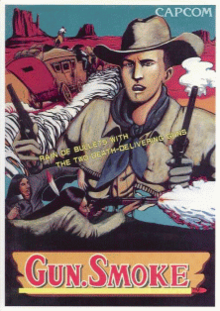
Athena is a 1986 platform arcade video game developed and published by SNK. Conversions were later released for the NES console and ZX Spectrum and Commodore 64 home computers.

1942 is a vertically scrolling shooter by Capcom that was released as an arcade video game in 1984. Designed by Yoshiki Okamoto, it was the first game in the 194X series, and was followed by 1943: The Battle of Midway.
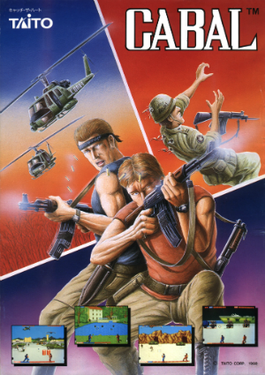
Cabal is a 1988 arcade shooter video game originally developed by TAD Corporation and published in Japan by Taito, in North America by Fabtek and in Europe by Capcom. In the game, the player controls a commando, viewed from behind, trying to destroy various enemy military bases. The game was innovative for the era, but only a mild success in the arcades, and became better known for its various home conversions.

The Nintendo VS. System is an arcade system developed and produced by Nintendo from 1984 to 1990. It is based on most of the same hardware as the Family Computer (Famicom), later released as the Nintendo Entertainment System (NES). Most of its games are conversions from the Famicom and NES, some heavily altered for the arcade format, and some debuted on the VS. System before being released on the Famicom or NES. The system focuses on two-player cooperative play. It was released in three different configurations: upright VS. UniSystem cabinets, upright VS. DualSystem cabinets, and sit-down VS. DualSystem cabinets. Games are on pluggable circuit boards, allowing for each side to have a different game.
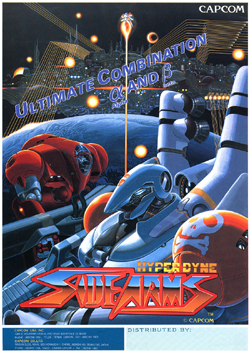
Hyper Dyne Side Arms (サイドアーム) is a horizontally scrolling shooter developed and released by Capcom as an arcade video game in 1986. The player takes control of a flying mecha fighter who must battle an alien army. Side Arms uses a two-directional attacking system similar to Capcom's previous shoot-'em-up Section Z.

Operation Wolf is a light gun shooter arcade game developed by Taito and released in 1987. It was ported to many home systems.

Commando, released as Senjō no Ōkami in Japan, is a vertically scrolling run and gun video game released by Capcom for arcades in 1985. The game was designed by Tokuro Fujiwara. It was distributed in North America by Data East, and in Europe by several companies including Capcom, Deith Leisure and Sega, S.A. SONIC. Versions were released for various home computers and video game consoles. It is unrelated to the 1985 film of the same name, which was released six months after the game.

Rush'n Attack, also known as Green Beret in Japan and Europe, is a run-and-gun and hack-and-slash video game developed and released by Konami for arcades in 1985, and later converted to the Nintendo Entertainment System and home computers. Its North American title is a play on the phrase "Russian attack" due to its Cold War setting. It was ported to home systems and became a critical and commercial success for arcades and home computers.
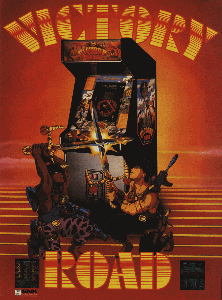
Victory Road, known as Dogō Sōken in Japan, is a run and gun video game released by SNK for arcades in 1986. It is the sequel to Ikari Warriors.

Trojan is a side-scrolling action game developed by Capcom, originally released as a coin-operated arcade game in 1986, and published in North America by Romstar and Capcom. Directed by Takashi Nishiyama, the game includes beat 'em up and hack-and-slash elements. It is a spiritual successor to the beat 'em up Kung-Fu Master (1984), which was designed by Nishiyama at Irem before he left for Capcom, where he evolved its gameplay concepts with Trojan. It is also considered a spiritual successor to Capcom's Ghosts 'n Goblins (1985), which has similar side-scrolling action gameplay elements.

Bomb Jack is a platform game published by Tehkan for arcades in and later ported to home systems. The game was a commercial success for arcades and home computers. It was followed by several sequels: the console and computer game Mighty Bomb Jack, the arcade game Bomb Jack Twin, and Bomb Jack II which was licensed for home computers only.

Vulgus is a vertically scrolling shooter video game developed and published by Capcom in Japan in 1984 and released in North America by SNK the same year. The game was Capcom's first video game. The game is included in Capcom Classics Collection and is available as freeware.

Forgotten Worlds, titled Lost Worlds in Japan, is a side-scrolling shooter video game by Capcom, originally released as a coin-operated arcade game in 1988. It is notable for being the first title released by Capcom for their CP System arcade game hardware.

Hyper Sports, known in Japan as Hyper Olympic '84, is an Olympic-themed sports video game released by Konami for arcades in 1984. It is the sequel to 1983's Track & Field and features seven new Olympic events. Like its predecessor, Hyper Sports has two run buttons and one action button per player. The Japanese release of the game sported an official license for the 1984 Summer Olympics.

Avengers, sometimes known as Avenger and known in Japan as Hissatsu Buraiken, is a 1986 overhead-view vertical scrolling beat 'em up arcade game developed and published by Capcom. The game was directed by Takashi Nishiyama, who previously designed the side-scrolling beat 'em ups Kung-Fu Master (1984) and Trojan (1986), and later designed the original Street Fighter (1987) and several early SNK fighting games.

Quartet (カルテット) is a run and gun video game released by Sega for arcades in 1986. Quartet allows one to four players to guide a set of characters through a base taken over by an army of robots. Players control either Joe (yellow), Mary (red), Lee (blue), or Edgar (green) across 32 side-scrolling levels. The object of the game is to advance through the level, fighting opponents that come out of portals in the walls, and eventually defeat a boss that carries the door key used to open the "exit door" for the level.
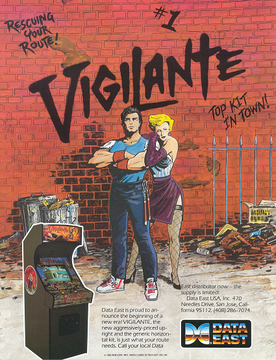
Vigilante (ビジランテ) is a 1988 beat 'em up arcade video game developed and published by Irem in Japan and Europe, and published in North America by Data East. It is considered as a spiritual sequel to Irem's earlier Kung-Fu Master (1984).
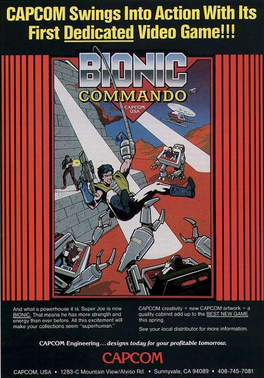
Bionic Commando, released in Japan as Top Secret is a run and gun platform game released by Capcom in arcades in 1987. It was designed by Tokuro Fujiwara as a successor to his earlier "wire action" platformer Roc'n Rope (1983), building on its grappling hook mechanic; he was also the designer of Commando (1985). The music was composed by Harumi Fujita for the Yamaha YM2151 sound chip.

T.A.N.K. is a vertically scrolling multidirectional shooter developed and released in arcades by SNK 1985. It was published in North America as TNK III by Kitcorp. Versions of T.A.N.K. for home computers were released by Ocean Software for the ZX Spectrum, Commodore 64, and Amstrad CPC in 1987. A sequel was also released for the Nintendo Entertainment System titled Iron Tank.
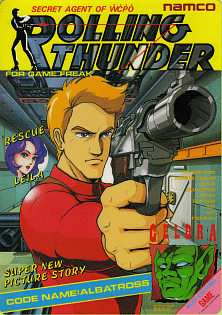
Rolling Thunder is a run and gun video game developed by Namco in Japan and Europe and released in 1986 as a coin-operated arcade video game using the Namco System 86 hardware. It was distributed in North America by Atari Games. The player takes control of a secret agent who must rescue his female partner from a terrorist organization. Rolling Thunder was a commercial success in arcades, and it was released for various home computer platforms in 1987 and the Nintendo Entertainment System in 1989. The original arcade game has been included in various classic game compilations as well. It influenced later arcade action franchises such as Shinobi and Time Crisis, which borrowed mechanics such as taking cover behind crates.
